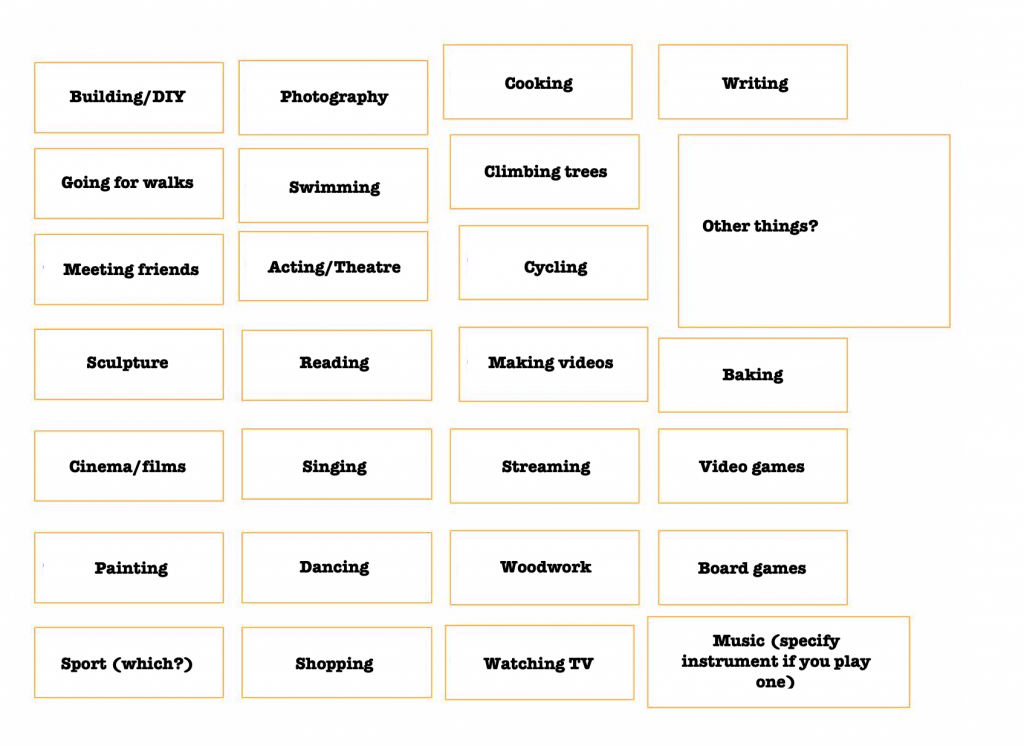This is an offline workshop designed for children. It aims at helping them better understand the issues and differences between digital and real world identities. They will be led to discover this by creating their own virtual identities and presenting them to the rest of the class.
General Objective
Preparation time for facilitator
Competence area
Time needed to complete activity (for learner)
Name of author
Support material needed for training
Resource originally created in
Introduction
The goal of this workshop is to get participants thinking about issues related to digital identity and, more broadly, about personal data. Each child will create their own digital identity in an offline setting.
Note to facilitator: If you can, print potential avatars to be used and if you have them, images of participants (maybe you have ID photos of each of them for example). You should also print pictures of settings such as beach, forest, or photos or group class photos if you have them (there are some examples in annex!) These will be photos that will be used for the photo gallery (see the digital identity sheets below). Tell participants that they can use a photo of for example a beach if they want to share something online from their seaside holiday. Print also the ID sheets provided: one per participant. We will leave you find, if you wish, your own avatar examples and more photos.
We are counting on you: be creative!
Facilitation tips: You can complement this workshop with ‘Digital Identity: Creating an Avatar‘ through which participants can create their own avatar using simple online tools. You can conclude this activity with a quick moving debate in order to get a sense of the group members’ opinions on the ideas of identity theft, the harvesting of user data by social media platforms, etc. For more detail on digital identity, see the workshop plan ‘Reflecting on Personal Data‘.
Defining personal identity
Start by giving a simple definition of identity. Here is one: Identity is a collection of traits, elements that define each individual and differentiate them from others.
Facilitation tips: You can give your own example to illustrate your example. It can consist of basic elements such as: ‘my name is Billiam Proudson, which is part of my identity. I was born on August 17th 1980.’ Or add more personal elements: ‘I wear glasses, I like surfing, I am a mechanic.’ Next explain that there is a difference between civil identity and digital identity. We cannot lie about our civil identity on our ID card/passport: the date and place of birth, address and other details are verifiable. Digital identity is who we are on the internet. We are not obliged to give our real name online or show our face. In reality, digital identity is that which we choose to show to other internet users. It comprises public information on us.
Creating a digital identity
Give out a blank digital identity sheet (in annex) to each participant. If you have enough time, participants will be able to include more photos or draw pictures to explain which images they might share to add to their digital identity. Explain the rules: each group member will have to create their own digital identity. To do this, they fill in the blank fields of the document in annex.
Remember to emphasise that while they don’t need to put true information, the things they do include have to make them recognisable online – there has to be a certain logic to the information. Give some examples like the following: The YouTuber Pewdiepie. Many people know who he is but presumably his real name is not Pewdiepie. Daft Punk is another good example: people will recognise their masked forms but very few people know the duo’s real names or faces! Ask participants if they have examples to see if they have understood the concept. Give out the markers, glue, scissors, etc. and let them start!
Emphasise that what counts is to be recognisable and that giving out true information carries risks. People online might use your personal information in order to pass themselves off as you. We call this identity theft. Brands and companies can also harvest information on you in order to target ads and products that you may be more susceptible to buy! When they are finished, allow them to present their virtual identities. Question them on the choice to include or omit true information.

 Example of photos to share: memories of a seaside holiday, a walk in the forest, of a sporting victory (football match or whatever else), playing with friends, on holidays with family, doing homework, hanging out with your dog/cat, etc.
Example of photos to share: memories of a seaside holiday, a walk in the forest, of a sporting victory (football match or whatever else), playing with friends, on holidays with family, doing homework, hanging out with your dog/cat, etc. 



